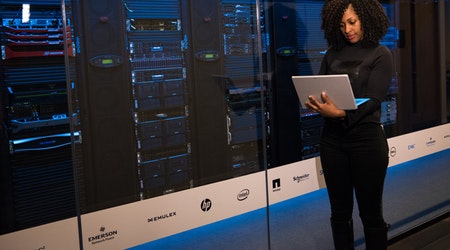Adding Data Center Scope Doesn't Have to Mean Build New
Renovate or build new? Answering this question is rarely easy, particularly when the facility in question is a data center. A range of considerations — from risks and costs, to power and cooling sources, to the structure's load-bearing capacity — must be analyzed and weighed. "There's no magic formula that points to either renovation or new construction," says Dennis Cronin, principal with Gilbane Mission Critical. "It all depends on where you are and where you need to go, geographically and technologically."
A renovation, of course, allows an organization to remain in its existing space. However, the renovation process can quickly become complex, particularly if all work must take place without any computer shutdowns. "It's like doing open heart surgery while the patient is at work," says Christopher Johnston, chief engineer, critical facilities with Syska Hennessey.
After all, the construction that's underway often takes place right next to complicated equipment that can cost millions of dollars and run mission-critical operations. "When workers go into a critical data center, you can see the sweat come off the CIO's brow," says Mark Evanko, principal engineer with BrunsPak. The issue isn't that the workers don't know what they're doing, he says. It's just that the stakes are so high.
What's more, given that many companies need to avoid shutdowns that will affect operations during their renovations, the time frame can easily exceed the time required to build a new center. That's because work often needs to be done in phases, which adds time, complexity and risk to the process, says Evanko. The extended time frame also will drive up costs.
Still, a data center renovation offers some advantages that building new typically doesn't. As a starting point, a renovation typically doesn't require a major technology migration plan to move into the new space. Moving the corporate network or telecommunications systems to a new location is itself complicated and expensive, says Alan Lehman, senior associate and group leader for critical facilities with George Butler Group.
In some cases, organizations decide to stay put and renovate their existing data centers for reasons that go beyond cost and technology. For instance, if management believes that maintaining its computer systems at its headquarters location provides it with a competitive advantage, it's unlikely to consider moving.
In the end, making the renovate-vs.-build decision is a matter of weighing the costs required to avoid downtime and mitigate risk during construction versus the cost and convenience of building new, Lehman says.
About 7x24 Exchange
The 7x24 Exchange, a New York-based non-profit organization, is the leading knowledge exchange for those who design, build, use and maintain mission-critical enterprise information infrastructures. The Exchange aims to be recognized as the most reliable and independent conduit to ideas, opinions and information on end-to-end reliability issues, and to ultimately improve reliability by promoting dialogue among those involved in mission-critical infrastructures.
This mission is promoted through annual conferences and a magazine, as well as the 7x24 exchange website (www.7x24exhange.org) and 17 affiliated chapters across the United States and in Europe.
Many of its member companies come from the aerospace, financial services, health care, pharmaceutical, manufacturing, utilities, government and technology sectors. The Exchange aims to be the largest organization of its type, with membership of at least 25 percent of the top 1,000 organizations in which end-to-end reliability is critical to their mission and operation.
"Members of 7x24 are able to access advanced information and knowledge from a range of subject matter experts," says Bob Cassiliano, chairman of 7x24 Exchange. For instance, at the recent fall conference, vice president David Schirmacher moderated a panel of representatives from the Data Center Metrics Coordination Task Force; Schirmacher represents the Exchange on the task force.
The 7x24 Exchange conferences also include sessions presented by experts from outside organizations, such as ASHRAE, the Green Grid, and the Uptime Institute. This enables conference participants to obtain a deep, broad perspective from a number of recognized authorities.
"The hot topic at the last several conferences has been energy efficiency," Cassiliano says. "The 7x24 Exchange is considered an industry stakeholder by the U.S. Department of Energy and the U.S. Environmental Protection Agency." In January, both Cassiliano and Schirmacher participated in a meeting in Washington, D.C., with the goal of setting standards and guiding principles for measuring energy efficiency in data centers. |
Related Topics:














